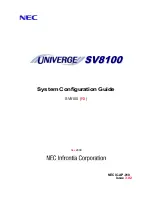
Architecture
1768
SPRUH82C – April 2013 – Revised September 2016
Copyright © 2013–2016, Texas Instruments Incorporated
Video Port Interface (VPIF)
35.2.5 Video Receive
VPIF channels 0 and 1 are used for video receive.
Y/C Mux
For BT.656 video, luminance (Y) and chrominance (C) values are multiplexed into a single byte-stream on
one channel (either channel 0 or channel 1).
For BT.1120 video, channels 0 and 1 function as a pair without Y/C multiplexing in the following
configuration:
•
Channel 0 receives Y data (C buffer settings for channel 0 are ignored)
•
Channel 1 receives C data (Y buffer settings for channel 1 are ignored)
The Y/C multiplex function for BT.656 video is enabled by setting the YCMUX bit in the channel control
registers C
n
CTRL. The YCMUX bit must be the same for both channels 0 and 1.
Receive Clocking
Each receive channel uses an input clock (CLKIN
n
) . When receive is enabled, video data is latched
synchronously with the rising edge of CLKIN
n
. The VPIF can be reconfigured to latch on the falling edge
of CLKIN
n
by setting the CLKEDGE bit in the C
n
CTRL register.
When receiving BT.1120 video data, the two receive channels operate as a pair. To ensure that video
data is received at the same time across both channels, the CLKIN
n
signals must share the same
reference clock.
Capture Mode
The CAPMODE bit of the C0CTRL and C1CTRL control registers determines what data format will be
captured by VPIF. The BT/YC video mode will look for video sync signals that are embedded within the
video byte stream (standard for BT video). The CCD/CMOS (Raw Data Capture) mode will look for video
sync signals on the dedicated VPIF sync pins (common for CCD and CMOS sensors).
When the CCD/CMOS mode is selected, channels 0 and 1 will work as a pair. Thus, both channels must
be enabled before VPIF will capture receive data.
Capture mode settings must be the same for both channels 0 and 1.
















































